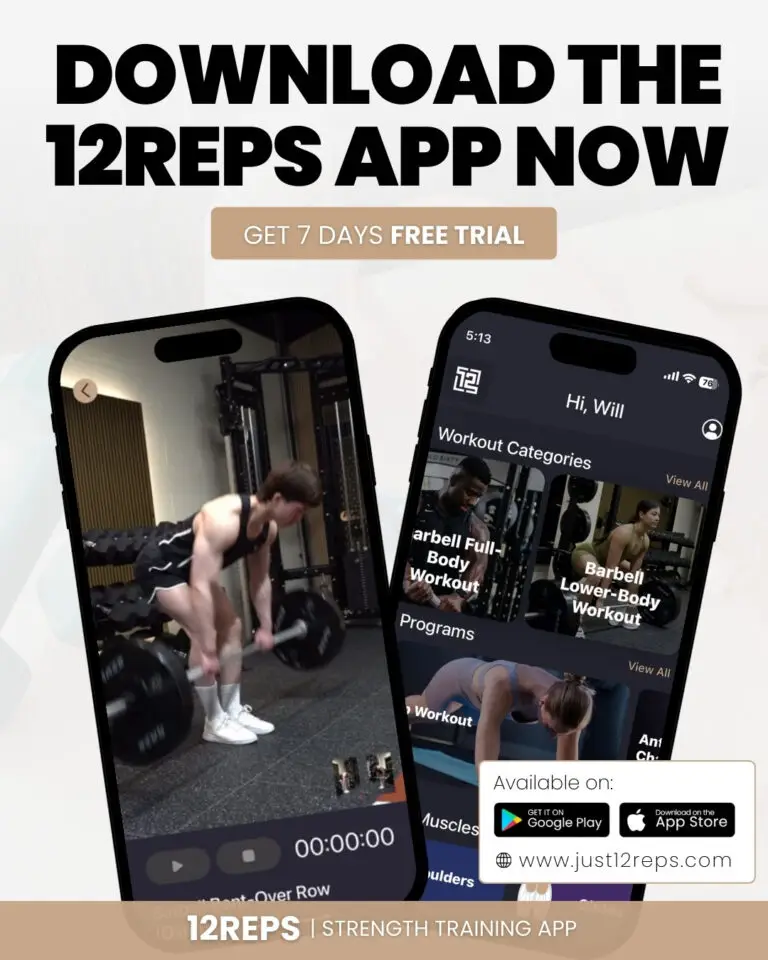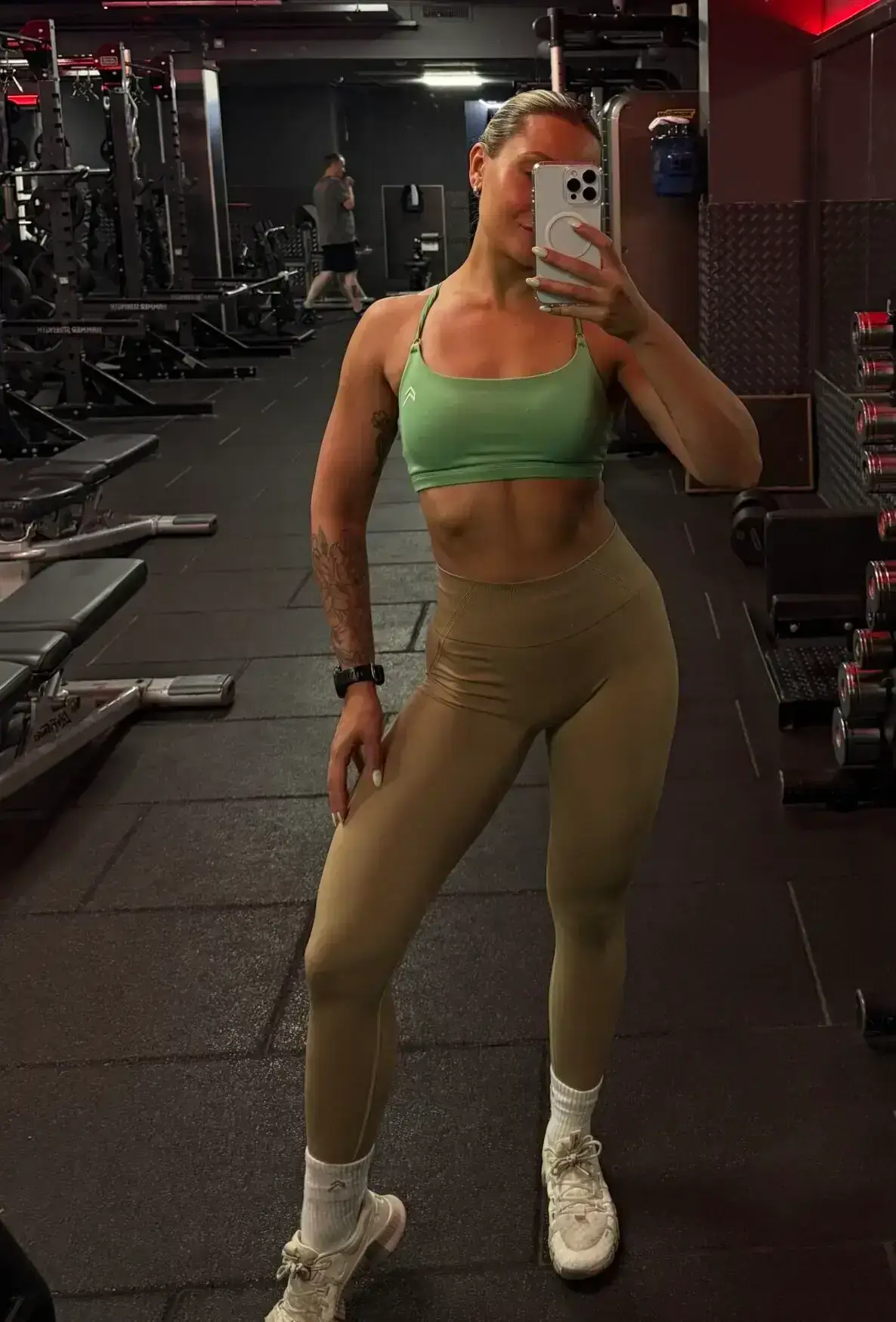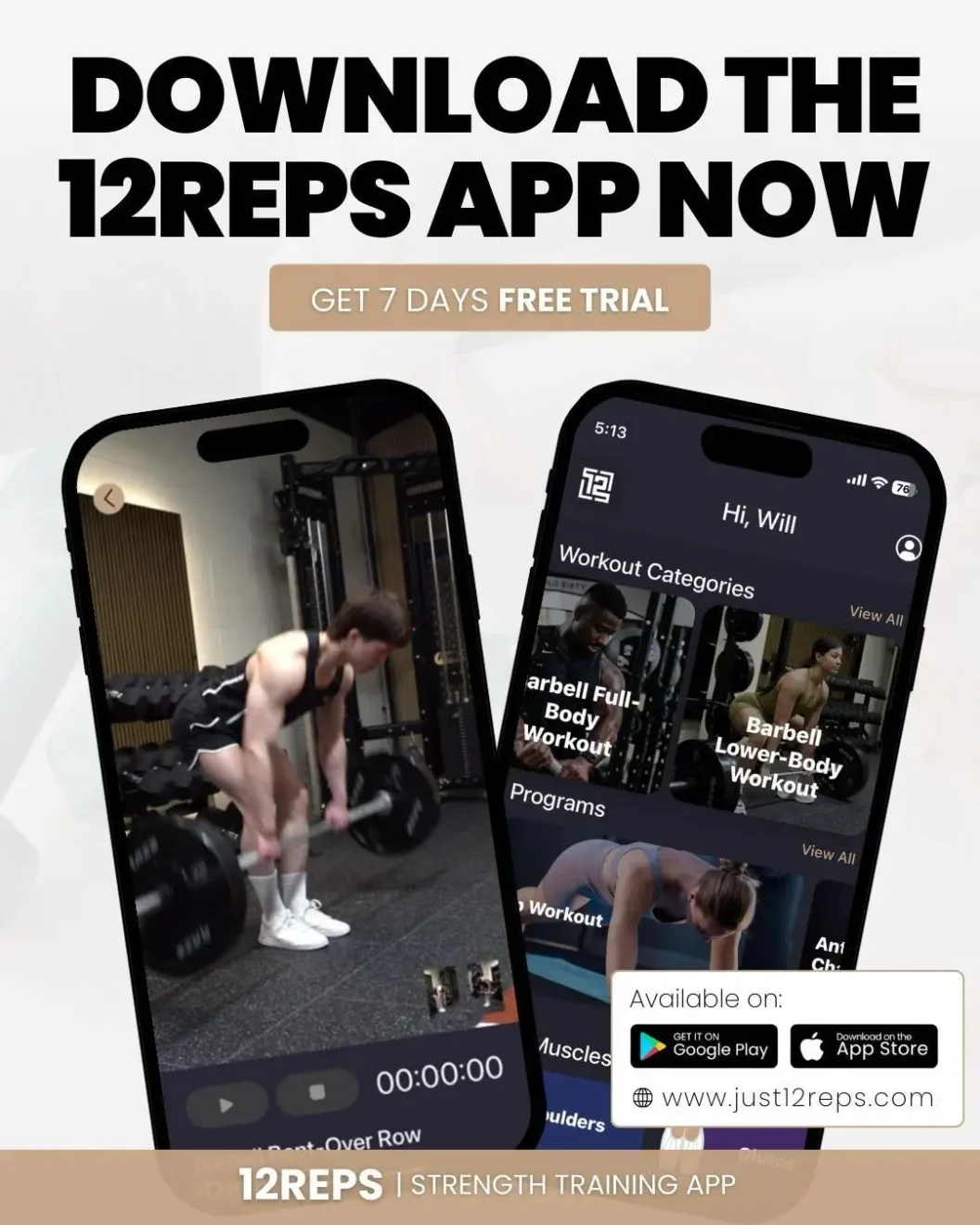Written by Will Duru, BSc (Hons) Sport and Exercise Science, award-winning Personal Trainer with over 10 years of experience in strength training and optimising recovery .
As a personal trainer with over a decade of experience helping clients achieve their fitness goals, I’ve witnessed firsthand the transformative power of a well-structured pull day workout. In our modern world of desk jobs, smartphone addiction, and sedentary lifestyles, the importance of training your posterior chain cannot be overstated. Today, I’m sharing with you a comprehensive pull day routine that will not only build impressive back strength but also dramatically improve your posture and overall quality of life.
The five exercises I’ve carefully selected for this workout target every major muscle group in your back, from the powerful latissimus dorsi to the often-neglected rhomboids and rear deltoids. Each movement has been chosen not just for its muscle-building potential, but for its ability to counteract the forward head posture and rounded shoulders that plague so many of my clients. Whether you’re a gym veteran looking to refine your technique or a beginner taking your first steps toward better posture, this routine will serve as your roadmap to a stronger, more confident you.
What sets this workout apart is its focus on functional movement patterns that directly translate to improved posture and daily activities. Every exercise demonstration and detailed form cue can be found in the 12Reps app, which I recommend to all my clients for its comprehensive exercise library and personalised training approach. The app’s filtering-powered recommendations ensure that you’re not just following a generic routine but receiving guidance tailored to your specific needs and goals.
This isn’t just another back workout; it’s a systematic approach to rebuilding your posterior chain from the ground up. By the end of this article, you’ll have everything you need to implement a pull day routine that will leave you standing taller, feeling stronger, and moving with the confidence that comes from a properly balanced physique.

Why Back Training is Your Posture's Best Friend
In my years of training clients, I’ve observed a disturbing trend that mirrors what researchers are calling a modern epidemic: postural dysfunction. The average person spends over eight hours a day hunched over a computer, followed by additional hours looking down at smartphones and tablets. This chronic forward head posture and rounded shoulder position creates a cascade of muscular imbalances that can lead to pain, reduced mobility, and a significant decrease in confidence and presence.
The human spine is designed to maintain specific curves that distribute weight efficiently and allow for optimal movement. When we consistently adopt poor postures, we strengthen the muscles that pull us into these compromised positions while simultaneously weakening the muscles responsible for maintaining proper alignment. The chest muscles become tight and overactive, while the upper back muscles, particularly the rhomboids, middle trapezius, and rear deltoids, become weak and inhibited.
This is where strategic back training becomes not just beneficial, but essential. The posterior chain muscles act as your body’s natural posture correctors, working tirelessly to pull your shoulders back, lift your chest, and maintain the natural curves of your spine. When these muscles are strong and properly activated, they create a muscular balance that naturally promotes better posture without conscious effort
What makes this approach particularly effective is that we’re not just building muscle; we’re teaching your body new movement patterns that will carry over into your daily life. Each repetition is an opportunity to reinforce proper posture mechanics, creating neural pathways that will eventually make good posture feel natural and effortless. The 12Reps app excels in this area, providing detailed movement cues and form corrections that ensure every rep contributes to your postural improvement goals.
The Complete Pull Day Workout: Your Blueprint for Better Posture
This carefully crafted workout targets every major muscle group in your back through five fundamental movement patterns. Each exercise builds upon the previous one, creating a comprehensive training session that will challenge your muscles while reinforcing proper postural mechanics.
Workout Overview
Exercise | Warm-up Set | Working Sets | Reps | Rest Between Sets |
Barbell Bent Over Row (Underhand Grip) | 1 x 15 (light weight) | 4 x 10-12 | 10-12 | 90-120 seconds |
Dumbbell Single Arm Row | 1 x 15 (light weight) | 4 x 10-12 | 10-12 each arm | 60-90 seconds |
Cable Rope Face Pull | 1 x 20 (light weight) | 4 x 10-12 | 10-12 | 60-90 seconds |
Machine Assisted Pull-Up | 1 x 10 (light assistance) | 4 x 10-12 | 10-12 | 90-120 seconds |
Machine Lat Pulldown | 1 x 15 (light weight) | 4 x 10-12 | 10-12 | 90-120 seconds |
Exercise 1: Barbell Bent Over Row (Underhand Grip)
The underhand barbell row is the cornerstone of any effective back-building routine, and for good reason. This compound movement targets the latissimus dorsi, rhomboids, middle trapezius, and biceps while teaching your body the fundamental hip-hinge pattern that’s essential for both athletic performance and daily activities.
Begin by setting up a barbell on a rack at about mid-shin height. Approach the bar with your feet hip-width apart and grip it with an underhand grip, hands positioned slightly wider than shoulder-width apart. The underhand grip allows for greater bicep involvement and often feels more natural for beginners, while still providing excellent activation of the back muscles.
Initiate the movement by pushing your hips back and maintaining a slight bend in your knees. Your torso should be angled at approximately 45 degrees to the floor, with your chest up and shoulders pulled back. This is your starting position, and maintaining this posture throughout the movement is crucial for both safety and effectiveness.
Pull the bar toward your lower chest and upper abdomen, focusing on initiating the movement by squeezing your shoulder blades together. Imagine trying to crack a walnut between your shoulder blades as you pull. The bar should travel in a straight line, and your elbows should stay close to your body rather than flaring out to the sides.
The eccentric or lowering portion of the movement is just as important as the pull. Control the weight as you lower it back to the starting position, feeling a stretch in your lats and maintaining tension throughout the entire range of motion. This controlled negative not only builds strength but also improves your ability to maintain proper posture under load.
Common mistakes I see with this exercise include using too much weight too soon, allowing the torso to rise up during the pull, and failing to achieve a full range of motion. Start with a weight that allows you to maintain perfect form for all repetitions, and remember that the goal is muscle development and postural improvement, not ego lifting. The 12Reps app provides excellent video demonstrations of proper form, including common mistakes to avoid and modifications for different experience levels.
Exercise 2: Dumbbell Single Arm Row
The single-arm dumbbell row is perhaps the most versatile back exercise in existence, offering unilateral training benefits that help address muscle imbalances while providing an excellent opportunity to focus on proper scapular mechanics. This exercise is particularly valuable for improving posture because it teaches each side of your back to work independently, ensuring that your stronger side doesn’t compensate for your weaker side.
Position yourself beside a flat bench with a dumbbell on the floor. Place your inside knee and hand on the bench for support, with your outside foot planted firmly on the ground. Your supporting arm should be straight, and your back should maintain its natural arch throughout the movement. This three-point stance provides excellent stability and allows you to focus entirely on the working muscles.
Reach down and grasp the dumbbell with your outside hand, allowing your arm to hang straight down from your shoulder. Your starting position should feel stable and balanced, with your core engaged to prevent any rotation or shifting during the movement.
Initiate the pull by driving your elbow back and up, keeping it close to your body. Focus on pulling your shoulder blade toward your spine as you lift the weight. The dumbbell should travel toward your hip rather than straight up, following the natural path that maximises lat and rhomboid activation.
At the top of the movement, squeeze your shoulder blade toward your spine and hold for a brief pause. This isometric contraction at the peak of the movement is where much of the postural benefit occurs, as it reinforces the muscle memory needed for proper shoulder blade positioning throughout your day.
Lower the weight under control, allowing your shoulder blade to protract slightly at the bottom to achieve a full stretch. This full range of motion ensures that you’re developing both strength and mobility, two essential components of healthy posture.
The beauty of the single-arm row lies in its ability to be modified for any fitness level. Beginners can start with lighter weights and focus on mastering the movement pattern, while advanced trainees can use heavier loads or incorporate pauses and tempo changes to increase the challenge. The 12Reps app offers progressive variations of this exercise, allowing you to advance systematically as your strength and technique improve.
Exercise 3: Cable Rope Face Pull
If I could choose only one exercise to combat the effects of modern posture problems, the cable rope face pull would be a strong contender. This movement specifically targets the rear deltoids, rhomboids, and lower trapezius muscles that are most affected by forward head posture and rounded shoulders. It’s also one of the most corrective exercises you can perform, actively reversing the internal rotation and protraction that characterises poor posture.
Set up a cable machine with a rope attachment at approximately chest height. Grasp the rope with both hands, using an overhand grip with your thumbs pointing toward you. Step back from the machine until you feel tension in the cable, and position your feet in a staggered stance for stability.
Begin with your arms extended in front of you, allowing your shoulder blades to protract slightly. This starting position mimics the rounded shoulder posture we’re trying to correct, making this exercise particularly functional for postural improvement.
Initiate the movement by pulling your elbows back and separating the rope as you pull it toward your face. The key is to focus on external rotation of the shoulders as you pull, which means your hands should end up beside your ears rather than at your chest. This external rotation component is what makes the face pull so effective for postural correction.
As you pull, imagine trying to touch your elbows to the wall behind you while simultaneously trying to show someone the backs of your hands. This visualisation helps ensure proper muscle activation and movement mechanics. Your shoulder blades should squeeze together at the peak of the movement, with your rear delts doing the majority of the work.
The return to the starting position should be controlled and deliberate. Resist the urge to let the weight snap back, as the eccentric portion of this movement is crucial for developing the strength and control needed for sustained postural improvements.
Many people make the mistake of using too much weight on face pulls, which leads to compensation patterns and reduces the exercise’s effectiveness. This is a movement where perfect form trumps heavy weight every time. Start light and focus on feeling the correct muscles working. The 12Reps app includes detailed form cues and common corrections that will help you master this essential movement.
Exercise 4: Machine-Assisted Pull-Up
The machine-assisted pull-up is a game-changing exercise that allows individuals of all fitness levels to experience the incredible benefits of vertical pulling movements. This exercise is particularly valuable for developing the latissimus dorsi, rhomboids, and middle trapezius while teaching proper scapular mechanics that are essential for maintaining upright posture throughout daily activities.
The assisted pull-up machine provides counterbalance support, allowing you to focus on proper form and muscle activation without being limited by your current strength levels. This makes it an excellent choice for building the foundation needed to perform unassisted pull-ups while providing immediate postural benefits eventually.
Begin by adjusting the machine’s weight stack to provide the appropriate level of assistance. Start with more help rather than less, as the goal is to maintain perfect form throughout all repetitions. The assistance weight should allow you to complete all sets with controlled movement and proper muscle activation.
Step onto the machine’s platform or knee pad, depending on the specific design of your gym’s equipment. Grasp the pull-up handles with an overhand grip, hands positioned slightly wider than shoulder-width apart. This wide grip position maximises lat activation while also engaging the middle trapezius and rhomboids.
Establish your starting position by allowing your arms to extend fully while maintaining a slight forward lean of your torso. Your shoulder blades should be in a neutral position, neither excessively protracted nor retracted. Engage your core to maintain stability throughout the movement.
Initiate the pull by depressing your shoulder blades and driving your elbows down and back. Focus on pulling your chest toward the bar rather than simply lifting your body weight. This mental cue ensures proper lat activation and helps maintain the slight forward lean that optimises muscle recruitment.
As you pull yourself up, imagine trying to squeeze a pencil between your shoulder blades. This visualisation helps ensure proper scapular retraction and middle trapezius activation. The movement should be smooth and controlled, with your chest leading the way toward the bar.
At the top of the movement, your chin should clear the bar with your chest up and shoulders back. Hold this position for a brief pause, feeling the contraction in your lats and middle back muscles. This isometric hold is crucial for developing the strength and muscle memory needed for improved posture.
The descent should be controlled and deliberate, taking approximately twice as long as the ascent. This eccentric emphasis builds strength throughout the entire range of motion while improving your ability to control your body position under load.
Common mistakes include using too little assistance and compromising form, allowing the shoulders to roll forward during the movement, and failing to achieve a full range of motion. The assisted pull-up should feel challenging but manageable, allowing you to focus on quality movement patterns rather than struggling to complete repetitions.
The beauty of the assisted pull-up lies in its progressive nature. As you become stronger, you can gradually reduce the assistance weight, eventually working toward unassisted pull-ups. The 12Reps app provides excellent progression tracking for this exercise, helping you systematically reduce assistance while maintaining proper form and consistent progress toward your strength goals.
Exercise 5: Machine Lat Pulldown
The lat pulldown serves as the perfect finishing exercise for our pull day routine, allowing you to target the latissimus dorsi with heavy resistance while maintaining perfect form. This exercise is particularly valuable for developing the wide, V-shaped back that not only looks impressive but also provides crucial support for spinal health and posture.
Adjust the lat pulldown machine so that your thighs fit comfortably under the leg pads when seated. Select a wide grip on the bar, with your hands positioned slightly wider than shoulder-width apart. The wide grip emphasises the lats while also engaging the middle trapezius and rhomboids.
Sit tall with your chest up and shoulders back. Before beginning the pull, engage your core and establish a slight backward lean of approximately 15-20 degrees. This position allows for optimal lat engagement and mimics the posture we want to reinforce throughout daily activities.
Initiate the pull by depressing your shoulder blades and driving your elbows down and back. Focus on pulling the bar to your upper chest rather than behind your neck, as this front pulldown variation is safer and more effective for most people. Imagine trying to put your shoulder blades in your back pockets as you pull.
The key to maximising the postural benefits of this exercise is to focus on the squeeze at the bottom of the movement. Hold the contracted position for a brief pause, feeling your lats and middle traps working to maintain the position. This isometric hold reinforces the muscle activation patterns needed for good posture.
Control the weight as you return to the starting position, allowing your arms to extend fully while maintaining tension in your lats. The stretch at the top of the movement is important for maintaining shoulder mobility and ensuring full muscle development.
Common mistakes include using momentum to pull the weight, leaning too far back, or failing to achieve a full range of motion. The lat pulldown should be a smooth, controlled movement that emphasises muscle activation over heavy weight. The 12Reps app provides excellent guidance on proper lat pulldown technique, including variations for different experience levels and specific postural needs.
Programming and Progression: Making Consistent Gains
The beauty of this pull day routine lies not just in its immediate effects, but in its potential for long-term progression and adaptation. As a personal trainer, I’ve learned that the most successful clients are those who understand how to systematically progress their workouts while listening to their body’s recovery needs.
For optimal results, perform this pull day workout 1-2 times per week, depending on your overall training schedule and recovery capacity. If you’re following a traditional push/pull/legs split, this routine fits perfectly into your weekly structure. For those using an upper/lower split, the exercises can be incorporated into your upper body days alongside pushing movements.
Progression should be gradual and systematic. Begin with weights that allow you to complete all sets and reps with perfect form, leaving 1-2 reps in reserve at the end of each set. Once you can complete all four working sets with 12 perfect repetitions, it’s time to increase the weight by 2.5-5 pounds for upper body exercises. The 12Reps app excels at tracking your progress and suggesting appropriate weight increases based on your performance and recovery patterns.
Recovery between pull day sessions is crucial for both muscle growth and postural improvements. The adaptations we’re seeking occur during rest periods, not during the workout itself. Ensure you’re getting adequate sleep, proper nutrition, and allowing at least 48 hours between intense back training sessions. The postural muscles we’re targeting are often overworked from daily activities, so giving them time to recover and adapt is essential for long-term success.

Conclusion: Your Journey to Better Posture Starts Now
The five exercises outlined in this pull day routine represent more than just a workout; they’re your pathway to better posture, reduced pain, and increased confidence. Each movement has been carefully selected to address the specific muscular imbalances created by our modern lifestyle while building the strength and stability needed for optimal spinal health.
Remember that consistency trumps intensity when it comes to postural improvements. The changes you’re seeking won’t happen overnight, but with dedicated practice and proper progression, you’ll begin to notice improvements in how you feel and move within just a few weeks. Your future self will thank you for the investment you’re making today in your postural health and overall well-being.
Download the 12Reps app today to access detailed video demonstrations of each exercise, personalised progression recommendations, and a comprehensive library of additional movements to support your fitness journey. Your stronger, more confident posture awaits








